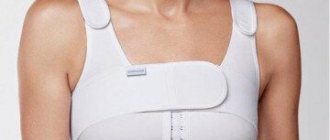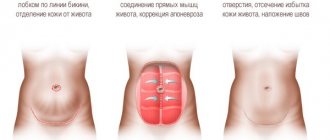Every year, the number of people wishing to undergo plastic surgery on the abdomen only increases. Patients are not afraid of postoperative scars, the complexity of the operation, or the long recovery period. This is not at all surprising, because the aesthetic result of the correction exceeds the wildest expectations: a beautiful, toned stomach of ideal shape without a trace of excess fat or stretch marks.
Since abdominoplasty is an abdominal surgery, the risk of possible complications after the intervention is quite high. To minimize risks, it is not enough to find a qualified doctor and a quality clinic. In plastic surgery of all types, the rehabilitation period plays an important role. The healing period and the invisibility of postoperative scars depend on how carefully the patient followed the doctor’s recommendations. Wearing compression garments after abdominoplasty is one of the key rules that a patient who wants to get an ideal result must adhere to.
What is it for?
During abdominoplasty, the surgeon makes extensive incisions and removes excess fat and skin tissue. Damage caused during surgery inevitably causes a response from the body. Violation of lymph flow leads to the release of fluid and the formation of swelling. In addition, after suturing, the tissues are in a tight position, which can threaten the seam divergence.
Postoperative underwear after abdominoplasty provides uniform pressure throughout the injured area, thereby preventing possible divergence of the wound edges by relieving tension. The bandage also effectively stimulates fluid circulation and promotes rapid resorption of swelling. Compression also has a beneficial effect on blood flow, fixes tissues in a new position, helping them take shape, and has a massage effect.
What will a post-operative bandage protect you from?
If you do not wear compression garments, swelling and hernias may appear, which will require additional surgery to correct.
In addition, the products are made from special materials that provide a massage effect. It has a beneficial effect on metabolism and blood circulation, accelerating the healing of sutures.
All you need to do is select the appropriate model in our catalog. Our online store offers bandages suitable for any figure.
Return to list
Principle of operation
The product is made from elastic fabric, dense enough to provide the required pressure, but at the same time breathable. The elastic properties of the fabric help create an even load on the entire area affected by the operation. It is very important that the pressure is soft and even. Too much or not enough pressure is equally harmful and will negatively impact recovery after surgery. Distributed compression provides support and fixation, stimulates the outflow of blood and lymph, and reduces the natural load on the muscles.
Wearing such clothing is a mandatory step in recovery.
To make wearing compression garments comfortable after abdominoplasty, you need to choose the right product. This can be done with the help of your surgeon or with the help of consultants in the store where you plan to purchase the product.
Types of products
Compression garments for women after abdominoplasty or any other plastic surgery may fall into one of the following categories:
- bandage,
- bodysuit,
- stockings.
Stockings are a separate category and are used in almost any surgical procedure to prevent blood clots due to low mobility. A bodysuit, unlike a bandage, has straps and is characterized by reduced pressure, so in the first days after correction the bodysuit is usually not worn.
Immediately after tummy tuck, it is recommended to wear a bandage that is located at the level of the abdominal cavity. This product can be either a regular wide belt around the waist, or a corset, briefs or pants with a high waistline, as well as something like a T-shirt or vest.
What types of bandage are there after tummy tuck?
The compression garments used can be divided into the following types:
1. Bandage – provides fixation of the tissues of the abdominal wall in a stationary position, creates uniform pressure on the abdominal organs.
Types of bandages:
- corset – secured with special fasteners at the waist;
- belt – a wide strip of dense elastic fabric without fasteners;
- inguinal bandage – appears in the form of high-waisted panties;
- pants – available in different lengths, provide additional compression of the legs;
- T-shirt, long sleeve - create uniform compression of the abdominal area, as well as the chest and arms.
2. Combidress - differs from a bandage in the presence of fixing straps on the shoulders and a lesser compressive effect. It is recommended several days after plastic surgery.
3. Stockings – their use is aimed at reducing the risk of thrombosis in the vessels of the lower extremities due to the patient’s low mobility after surgery and increased blood clotting.
It is very important that compression garments fit well. After all, too tight underwear will disrupt blood and lymph flow, and if it turns out to be too big, it will not fully perform its functions.
An ideally selected bandage fits the stomach and waist, like a glove, and does not cause any discomfort while wearing. A plastic surgeon will help you choose the most suitable bandage option, taking into account the individual characteristics of the patient’s anatomy, as well as the nuances of the performed abdominoplasty.
To prevent wearing compression garments from causing unnecessary discomfort, especially for patients with sensitive skin, you should choose a bandage made from natural fabrics with a high cotton content. This ensures good air circulation, despite the tight fit, the body will not overheat or sweat.
The fixation of the bandage is extremely important, so you need to pay attention to the reliability of the fasteners. The ability to adjust the size is also very important, because the severity of swelling in the first time after surgery varies greatly. Bandages without seams are more comfortable, as they do not compress blood vessels and do not provoke microcirculation and lymphatic drainage disorders.
How to choose
The quality of rehabilitation after the intervention depends on the right choice. The main characteristics by which you should choose shapewear after abdominoplasty:
- size,
- pressure force (as recommended by the surgeon),
- material,
- comfort.
Size is one of the main criteria when choosing. An incorrectly selected size will either not provide the necessary compression or will contribute to excess pressure, which entails significant discomfort when wearing. To avoid possible problems and mistakes in the question of which underwear is best to choose after abdominoplasty, it is recommended to purchase a product with the ability to adjust the size. This is important, since body volumes change noticeably after surgery, and ideally fitting underwear before surgery may not fit after surgery.
It is better to give preference to clothes made from high-quality hypoallergenic materials - nylon or spandex. The cotton base will give additional comfort to the body. It is also important to pay attention to how comfortable the product fits. If seams, ribs or fasteners chafe or otherwise cause discomfort, these garments will only cause pain.
Types of corsets for the abdominal cavity
Before choosing a postoperative bandage, you need to know what types of these medical products exist.
They are similar in appearance and consist of a wide elastic belt wrapped around the waist with fasteners. There are fasteners in the form of laces, hooks, and snap elements. But the presence of such fasteners can cause discomfort - laces can rub, hooks and latches can injure the skin. The best fastener is wide adhesive tape. It not only holds the belt firmly, but also helps regulate its tension, which is very important during the rehabilitation period.
The type of bandage is chosen depending on which internal organ the operation was performed on. There are special corsets for the rehabilitation of ostomy patients who have undergone surgical procedures on the intestines. These models have a special hole for feces drainage.
A separate type of constriction is anti-hernia belts. Such support is prescribed in two cases:
- after removal of a hernia;
- to prevent their occurrence.
Some types of bandages not only fix internal organs in the correct position, but also perform an additional role: they relieve the spine and back muscles, taking on part of their functions.
Advantages
Abdominoplasty requires wearing compression garments. There are many positive benefits to wearing such clothing. For example, by stimulating fluid circulation, the bandage helps swelling go away quickly. In addition, after surgery, the body produces substances that increase blood clotting. Due to this physiological feature, the risks of blood clot formation and separation increase. Compression normalizes blood flow and prevents the formation of blood clots.
Wearing a bandage also has an effect similar to a massage, which has a beneficial effect on tissue healing and the speed of recovery of the operated area after injury. Compression also prevents possible postoperative discomfort associated with body movements and allows you to feel a little more free during everyday physical activity.
After surgery, there is a high risk of complications such as suture dehiscence due to high tissue tension. The most important advantage is that the underwear after abdominoplasty fixes the edges of the wound and prevents the seam from coming apart.
Compression prevents the seams from coming apart.
Recovery period at home
Returning home after surgery, many patients forget that they have an early rehabilitation period in which they need to strictly follow the instructions. They are overwhelmed by everyday life (cleaning, going to the supermarket) - and as a result, uncomfortable phenomena arise.
Don’t forget the basic rules for recovery at home:
- wearing a bandage. This is important to stabilize the result and reduce the risk of postoperative complications. You must wear a bandage on the recommendation of a plastic surgeon. Usually: 2 weeks the bandage is worn continuously; then, after a routine examination, the surgeon gives further recommendations. The total duration of wearing the bandage can be 3-4 weeks. Then you can switch to shapewear.
- restriction of physical activity. This means lifting weights (more than 3 kg), carrying children in your arms, playing sports, fitness, swimming in the pool, visiting saunas and baths. The first time after surgery you need to take care of yourself. However, this does not mean that you need to drop out of social life. Walking and doing light household chores are allowed.
- intimate life. There are no strict restrictions on this issue. Here you should focus on your feelings. And, of course, do not allow pain in the operated area.
- limiting tanning (solariums). It is not recommended to expose the operated area to direct ultraviolet light. You should also refrain from going to the solarium.
- taking medications. They are prescribed only by your plastic surgeon. Coordinate taking medications only with him.
How long to wear compression garments after abdominoplasty?
Clothes are put on immediately after surgery. The period of wearing in each situation is determined individually. Only the surgeon can announce the removal time. You are not allowed to take off your clothes before the specified time.
The answer to the question of how long to wear compression garments in the exact size during abdominoplasty will be individual in each case. As a rule, this period is at least 2-3 weeks of round-the-clock wearing and about three months of constant use. In the first weeks after correction, the product must not be removed at all, including at night.
To obtain lasting results, it is usually recommended to wear the bandage for at least six months. All questions about timing, reducing the degree of compression or removal should be resolved only by a doctor. You should not remove compression products before the set date, remove them at night without the surgeon’s permission, or adjust the pressure level.
What happens if you don't wear it?
Compression garments for women after abdominoplasty are a must for a successful recovery. If this requirement is violated, you may encounter a number of unpleasant consequences and complications, even the most serious ones. It could be:
- long healing,
- severe pain,
- seam divergence,
- the appearance of keloid scars,
- umbilical hernia,
- thromboembolism.
These are not all the complications, the likelihood of which increases when you refuse to wear underwear. Therefore, this rule should be strictly observed. An attempt to move clothing, adjust tension, or in any other way influence the position of the product on the body will also not have the best effect on the aesthetic result, and in the most severe cases, on health.
Factors affecting recovery time
The duration of rehabilitation is determined by the following factors:
- volume and technique of surgical intervention;
- the age of the patient (the older the person, the slower the healing process);
- the patient’s lifestyle (healthy eating and the absence of bad habits contribute to faster recovery);
- postoperative care - how conscientiously the patient follows the doctor’s recommendations (wearing compression garments, diet, restrictions on physical activity).








